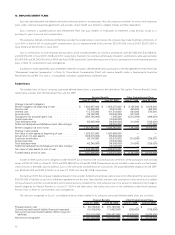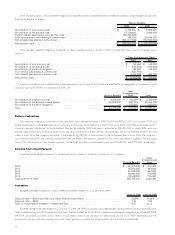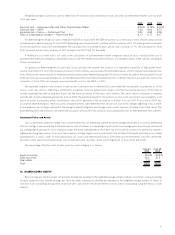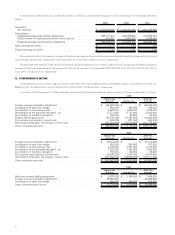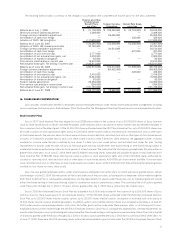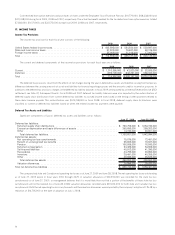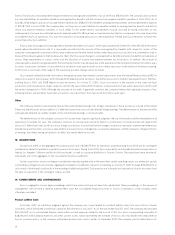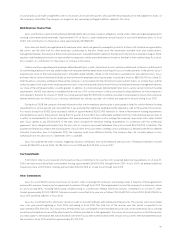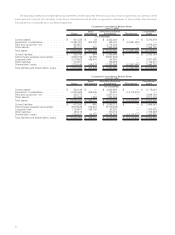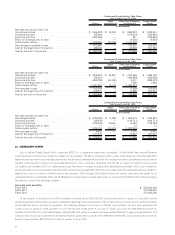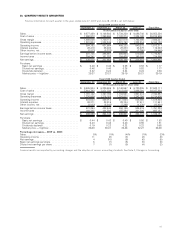Sysco 2009 Annual Report Download - page 77
Download and view the complete annual report
Please find page 77 of the 2009 Sysco annual report below. You can navigate through the pages in the report by either clicking on the pages listed below, or by using the keyword search tool below to find specific information within the annual report.
Effective Tax Rates
Reconciliations of the statutory federal income tax rate to the effective income tax rates for each fiscal year are as follows:
2009 2008 2007
United States statutory federal income tax rate ....................................... 35.00% 35.00% 35.00%
State, local and foreign income taxes, net of any applicable federal income tax benefit . ........... 1.63 1.14 2.15
Impact of provisions for uncertain tax benefits . ....................................... 1.75 0.64 —
Impact of adjusting carrying value of corporate-owned life insurance policies to their cash surrender
values .................................................................. 0.95 0.19 (0.52)
Impact of share-based compensation . ............................................. 0.59 0.85 0.93
Other . ................................................................... 0.45 0.43 0.69
40.37% 38.25% 38.25%
The effective tax rate for fiscal 2009 was negatively impacted primarily by two factors. First, the company recorded tax adjustments related to
federal and state uncertain tax positions of $31,000,000. Second, the loss of $43,812,000, which had a tax effect of $16,824,000, recorded to adjust
the carrying value of corporate-owned life insurance to their cash surrender values was non-deductible for income tax purposes and had the impact
of increasing the effective tax rate for the period.The effective tax rate for fiscal 2009 was favorably impacted by the reversal of valuation allowances
of $7,800,000 previously recorded on Canadian net operating loss deferred tax assets.
The effective tax rate for fiscal 2008 was favorably impacted by tax benefits of approximately $7,700,000 resulting from the recognition of a
net operating loss deferred tax asset which arose due to a state tax law change, $8,600,000 related to the reversal of valuation allowances
previously recorded on Canadian net operating loss deferred tax assets and $5,500,000 related to the reduction in net Canadian deferred tax
liabilities due to a federal tax rate reduction.The effective tax rate for fiscal 2008 was negatively impacted by the recording of tax and interest related
to uncertain tax positions, share-based compensation expense and the recognition of losses of $8,718,000, which had a tax effect of $3,348,000,
recorded to adjust the carrying value of corporate-owned life insurance policies to their cash surrender values.
The effective tax rate for fiscal 2007 was favorably impacted by the recognition of gains of $23,922,000, which had a tax effect of $9,186,000,
recorded to adjust the carrying value of corporate-owned life insurance policies to their cash surrender values. The effective tax rate for fiscal 2007
was negatively impacted by the recognition of tax and interest for tax contingencies.
Sysco’s option grants include options that qualify as incentive stock options for income tax purposes. The treatment of the potential tax
deduction, if any, related to incentive stock may cause variability in the company’s effective tax rate. In the period the compensation cost related to
incentive stock options is recorded, a corresponding tax benefit is not recorded as it is assumed that the company will not receive a tax deduction
related to such incentive stock options. The company may be eligible for tax deductions in subsequent periods to the extent that there is a
disqualifying disposition of the incentive stock option. In such cases, the company would record a tax benefit related to the tax deduction in an
amount not to exceed the corresponding cumulative compensation cost recorded in the financial statements on the particular options multiplied by
the statutory tax rate.
Sysco recorded a tax benefit of $9,907,000 or 17.7% of the $56,030,000 in share-based compensation expense recorded in fiscal 2009. Sysco
recorded a tax benefit of $15,722,000 or 19.5% of the $80,650,000 in share-based compensation expense recorded in fiscal 2008. Sysco recorded
a tax benefit of $21,549,000 or 22.0% of the $97,985,000 in share-based compensation expense recorded in fiscal 2007.
Uncertain Tax Positions
Prior to fiscal 2008, in evaluating the exposures connected with the various tax filing positions, the company established an accrual when,
despite management’s belief that the company’s tax return positions are supportable, management believed that certain positions may be
successfully challenged and a loss was probable. When facts and circumstances changed, these accruals were adjusted.
As discussed in Note 2, Changes in Accounting, the company adopted FIN 48 effective July 1, 2007. FIN 48 provides that a tax benefit from an
uncertain tax position is recognized when it is more likely than not that the position will be sustained upon examination, including resolutions of any
related appeals or litigation processes, based on the technical merits of the position. The amount recognized is measured as the largest amount of tax
benefit that has a greater than 50% likelihood of being realized upon settlement. As a result of this adoption, the company recognized, as a
cumulative effect of change in accounting principle, a $91,635,000 decrease in its beginning retained earnings on its July 1, 2007 balance sheet. A
reconciliation of the beginning and ending amount of gross unrecognized tax benefits, excluding interest and penalties, is as follows:
2009 2008
Unrecognized tax benefits at beginning of year ...................................... $ 87,929,000 $ 82,639,000
Additions for tax positions related to prior years ..................................... 21,645,000 —
Reductions for tax positions related to prior years .................................... (1,959,000) (138,000)
Additions for tax positions related to the current year. ................................. 10,935,000 7,912,000
Reductions for tax positions related to the current year . . . ............................. — —
Reductions due to settlements with taxing authorities ................................. (24,817,000) (223,000)
Reductions due to lapse of applicable statute of limitations. ............................. (1,588,000) (2,261,000)
Unrecognized tax benefits at end of year . . ........................................ $ 92,145,000 $ 87,929,000
As of June 27, 2009, the gross amount of accrued interest liabilities related to unrecognized tax benefits was $146,998,000, of which
$41,000,000 is classified within accrued income taxes as payment is anticipated during fiscal 2010. See further discussion in Note 22, Subsequent
57



